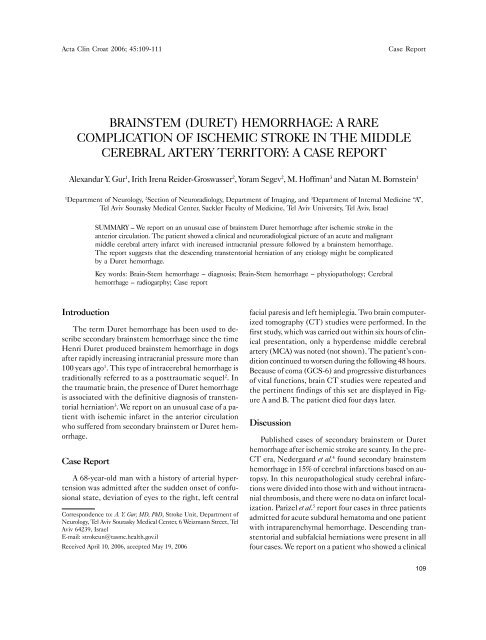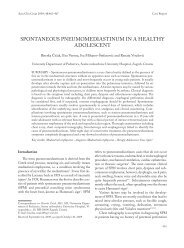07 Gur.p65
07 Gur.p65
07 Gur.p65
You also want an ePaper? Increase the reach of your titles
YUMPU automatically turns print PDFs into web optimized ePapers that Google loves.
A. Acta Y. <strong>Gur</strong> Clin et al. Croat 2006; 45:109-111 Duret Case hemorrhage Report<br />
BRAINSTEM (DURET) HEMORRHAGE: A RARE<br />
COMPLICATION OF ISCHEMIC STROKE IN THE MIDDLE<br />
CEREBRAL ARTERY TERRITORY: A CASE REPORT<br />
Alexandar Y. <strong>Gur</strong> 1 , Irith Irena Reider-Groswasser 2 , Yoram Segev 2 , M. Hoffman 3 and Natan M. Bornstein 1<br />
1 Department of Neurology, 2 Section of Neuroradiology, Department of Imaging, and 3 Department of Internal Medicine “A”,<br />
Tel Aviv Sourasky Medical Center, Sackler Faculty of Medicine, Tel Aviv University, Tel Aviv, Israel<br />
Introduction<br />
SUMMARY – We report on an unusual case of brainstem Duret hemorrhage after ischemic stroke in the<br />
anterior circulation. The patient showed a clinical and neuroradiological picture of an acute and malignant<br />
middle cerebral artery infarct with increased intracranial pressure followed by a brainstem hemorrhage.<br />
The report suggests that the descending transtentorial herniation of any etiology might be complicated<br />
by a Duret hemorrhage.<br />
Key words: Brain-Stem hemorrhage – diagnosis; Brain-Stem hemorrhage – physiopathology; Cerebral<br />
hemorrhage – radiogarphy; Case report<br />
The term Duret hemorrhage has been used to describe<br />
secondary brainstem hemorrhage since the time<br />
Henri Duret produced brainstem hemorrhage in dogs<br />
after rapidly increasing intracranial pressure more than<br />
100 years ago 1 . This type of intracerebral hemorrhage is<br />
traditionally referred to as a posttraumatic sequel 2 . In<br />
the traumatic brain, the presence of Duret hemorrhage<br />
is associated with the definitive diagnosis of transtentorial<br />
herniation 3 . We report on an unusual case of a patient<br />
with ischemic infarct in the anterior circulation<br />
who suffered from secondary brainstem or Duret hemorrhage.<br />
Case Report<br />
A 68-year-old man with a history of arterial hypertension<br />
was admitted after the sudden onset of confusional<br />
state, deviation of eyes to the right, left central<br />
Correspondence to: A. Y. <strong>Gur</strong>, MD, PhD, Stroke Unit, Department of<br />
Neurology, Tel Aviv Sourasky Medical Center, 6 Weizmann Street, Tel<br />
Aviv 64239, Israel<br />
E-mail: strokeun@tasmc.health.gov.il<br />
Received April 10, 2006, accepted May 19, 2006<br />
facial paresis and left hemiplegia. Two brain computerized<br />
tomography (CT) studies were performed. In the<br />
first study, which was carried out within six hours of clinical<br />
presentation, only a hyperdense middle cerebral<br />
artery (MCA) was noted (not shown). The patient’s condition<br />
continued to worsen during the following 48 hours.<br />
Because of coma (GCS-6) and progressive disturbances<br />
of vital functions, brain CT studies were repeated and<br />
the pertinent findings of this set are displayed in Figure<br />
A and B. The patient died four days later.<br />
Discussion<br />
Published cases of secondary brainstem or Duret<br />
hemorrhage after ischemic stroke are scanty. In the pre-<br />
CT era, Nedergaard et al. 4 found secondary brainstem<br />
hemorrhage in 15% of cerebral infarctions based on autopsy.<br />
In this neuropathological study cerebral infarctions<br />
were divided into those with and without intracranial<br />
thrombosis, and there were no data on infarct localization.<br />
Parizel et al. 5 report four cases in three patients<br />
admitted for acute subdural hematoma and one patient<br />
with intraparenchymal hemorrhage. Descending transtentorial<br />
and subfalcial herniations were present in all<br />
four cases. We report on a patient who showed a clinical<br />
Acta Clin Croat, Vol. 45, No. 2, 2006 109
A. Y. <strong>Gur</strong> et al. Duret hemorrhage<br />
A B<br />
Fig. 1. (A) A large subacute infarction involving the cortical and subcortical right middle cerebral artery territory, including marked<br />
midline shift to the left and contralateral hydrocephaluseen. (B) A brainstem Duret hemorrhage (curved arrow), seen as the blood<br />
present in the fourth ventricle. The area was normal on the first study.<br />
and neuroradiological picture of an acute and large<br />
ischemic stroke in the anterior circulation. The stroke<br />
was followed by a brainstem hemorrhage as the result of<br />
a malignant MCA infarct with increased intracranial pressure<br />
that resulted in transtentorial herniation.<br />
Our case report suggests that there are multifactorial<br />
reasons for delayed secondary brainstem or Duret hemorrhage,<br />
and that descending transtentorial herniation<br />
of any etiology might be complicated by a Duret hemorrhage.<br />
Acknowledgment. We thank Esther Eshkol for editorial<br />
assistance.<br />
References<br />
1. ALEXANDER E Jr, KUSHNER J, SIX EG. Brainstem hemorrhages<br />
and increased intracranial pressure: from Duret to computed<br />
tomography. Surg Neurol 1982;17:1<strong>07</strong>-10.<br />
2. CAPLAN LR, ZERVAZ NT. Survival with permanent midbrain<br />
dysfunction after surgical treatment of traumatic subdural<br />
hematoma: the clinical picture of a Duret hemorrhage? Ann<br />
Neurol 1977;1:587-9.<br />
3. HOLLAND BA, BRANT-ZAWADZKI M, PITTS LH. The role<br />
of CT in the evaluation of trauma. Second edition. Baltimore:<br />
Williams & Wilkins, 1986:1-3.<br />
4. NEDERGAARD M, KLINKEN BM, PAULSON OB. Secondary<br />
brain stem hemorrhage in stroke. Stroke 1986;4:501-5.<br />
5. PARIZEL PM, MAKKAT S, JORENS PG et al. Brainstem<br />
hemorrhage in descending transtentorial herniation (Duret<br />
hemorrhage). Intensive Care Med 2002;28:85-8.<br />
110 Acta Clin Croat, Vol. 45, No. 2, 2006
A. Y. <strong>Gur</strong> et al. Duret hemorrhage<br />
Sažetak<br />
DURETOVO KRVARENJE: RIJETKA KOMPLIKACIJA ISHEMIJSKOG MOŽDANOG UDARA U PODRUÈJU<br />
SREDIŠNJE MOŽDANE ARTERIJE – PRIKAZ SLUÈAJA<br />
A. Y. <strong>Gur</strong>, I. I. Reider-Groswasser, Y. Segev, M. Hoffman i N. M. Bornstein<br />
Opisuje se rijedak sluèaj Duretova krvarenja moždanoga debla nakon ishemijskog moždanog udara u prednjem krvotoku.<br />
Bolesnik je pokazivao klinièku i neuroradiološku sliku akutnog i zloæudnog infarkta središnje moždane arterije uz povišen<br />
intrakranijski tlak, nakon èega je uslijedilo krvarenje u moždanom deblu. Ovaj prikaz ukazuje na to da se Duretovo krvarenje<br />
može pojaviti kao komplikacija kod silazne transtentorijske hernijacije bilo koje etiologije.<br />
Kljuène rijeèi: Krvarenje u moždanom deblu – klinièka slika; Krvarenje u moždanom deblu – fiziopatologija; Krvarenje u<br />
moždanom deblu – neurološka obrada<br />
Acta Clin Croat, Vol. 45, No. 2, 2006 111






